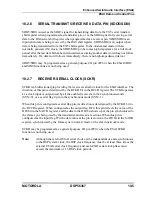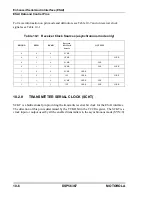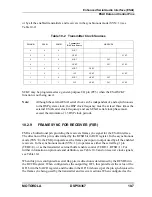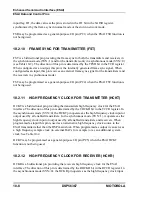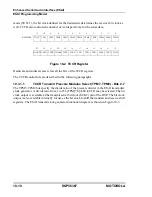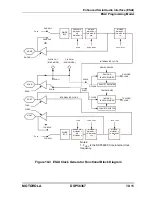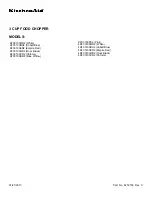
9-26
DSP56367
MOTOROLA
Serial Host Interface
SHI Programming Considerations
The HREQ output pin, if enabled for receive (HRQE[1:0] = 01), is asserted when the IOSR is
ready to receive and the HRX FIFO is not full; this operation guarantees that the next received
data word is stored in the FIFO. HREQ is deasserted at the first clock pulse of the next
received word. The HREQ line may be used to interrupt the external I
2
C master device.
Connecting the HREQ line between two SHI-equipped DSPs, one operating as an I
2
C master
device and the other as an I
2
C slave device, enables full hardware handshaking.
9.7.3.2
Transmit Data In I
2
C Slave Mode
A transmit session is initiated when the personal slave device address has been correctly
identified and the R/W bit of the received slave device address byte has been set. Following a
transmit initiation, the IOSR is loaded from HTX (assuming the latter was not empty) and its
contents are shifted out, MSB first, on the SDA line. Following each transmitted byte, the SHI
controller samples the SDA line at the ninth clock pulse, and inspects the ACK status. If the
transmitted byte was acknowledged (ACK = 0), the SHI controller continues and transmits the
next byte. However, if it was not acknowledged (ACK = 1), the transmit session is stopped
and the SDA line is released. Consequently, the external master device may generate a stop
event in order to terminate the session.
HTX contents are transferred to IOSR when the complete word (according to HM[1:0]) has
been shifted out. It is, therefore, the responsibility of the programmer to select the correct
number of bytes in an I
2
C frame so that they fit in a complete number of words. For this
purpose, the slave device address byte does not count as part of the data; therefore, it is treated
separately.
In a transmit session, only the transmit path is enabled and the IOSR-to-HRX FIFO transfers
are inhibited. When the HTX transfers its valid data word to IOSR, the HTDE status bit is set
and the DSP may write a new data word to HTX with either DSP instructions or DMA
transfers.
If HCKFR is cleared and both IOSR and HTX are empty when the master device attempts a
transmit session, an underrun condition occurs, setting the HTUE status bit, and the previous
word is retransmitted.
If HCKFR is set and both IOSR and HTX are empty when the master device attempts a
transmit session, the SHI holds the clock line to GND to avoid an underrun condition.
The HREQ output pin, if enabled for transmit (HRQE[1:0] = 10), is asserted when HTX is
transferred to IOSR for transmission. When asserted, HREQ indicates that the slave device is
ready to transmit the next data word. HREQ is deasserted at the first clock pulse of the next
transmitted data word. The HREQ line may be used to interrupt the external I
2
C master
device. Connecting the HREQ line between two SHI-equipped DSPs, one operating as an I
2
C
master device and the other as an I
2
C slave device, enables full hardware handshaking.
Summary of Contents for DSP56367
Page 16: ...xvi MOTOROLA CONTENTS Paragraph Number Title Page Number ...
Page 22: ...xxii MOTOROLA List of Figures Figure Number Title Page Number ...
Page 26: ...xxvi MOTOROLA List of Tables Table Number Title Page Number ...
Page 148: ...4 6 DSP56367 MOTOROLA Design Considerations PLL Performance Issues ...
Page 248: ...9 30 DSP56367 MOTOROLA Serial Host Interface SHI Programming Considerations ...
Page 306: ...10 58 DSP56367 MOTOROLA Enhanced Serial Audio Interface ESAI ESAI Initialization Examples ...
Page 389: ...Bootstrap ROM Contents MOTOROLA DSP56367 A 15 end ...
Page 390: ...A 16 DSP56367 MOTOROLA Bootstrap ROM Contents ...
Page 432: ...C 8 DSP56367 MOTOROLA JTAG BSDL ...
Page 484: ...D 52 DSP56367 MOTOROLA Programmer s Reference ...
Page 490: ...E 6 DSP56367 MOTOROLA Power Consumption Benchmark ...
Page 516: ...F 26 DSP56367 MOTOROLA IBIS Model ...
Page 522: ...Index 6 MOTOROLA Index ...
Page 523: ......
























